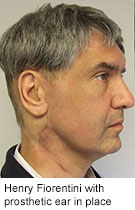
FRIDAY, April 11, 2014 (HealthDay News) — During his 10-year struggle with basal cell carcinoma, Henry Fiorentini emerged minus his right ear, and minus the hearing that goes with it.
The good news: Today, the 56-year-old IT programmer and consultant from Chicago is now roughly five years cancer free. And he’s also the proud owner of an incredibly lifelike silicone prosthetic replacement ear that imperceptibly attaches to his face by means of surgically implanted magnets.
“Recently I visited a doctor I didn’t know,” Fiorentini said, “and I explained that I don’t hear in one ear and that it’s fake. And he said: ‘Really? Which one?’ “
“And that’s a doctor looking at me from six inches away,” he chuckled. “So you know it’s pretty damn good.”
Indeed, Fiorentini said his situation today is about “as normal as if the cancer had never happened.” And for that he gives much credit to the “miraculous 10-seconds-and-it’s-on” design of his flesh-colored prosthesis.
But before entertaining the possibility of a new cutting-edge ear, Fiorentini first had to win a fight against cancer that he very nearly lost.
In 1998, a 40-year-old Fiorentini underwent a procedure to remove what had been diagnosed as basal cell carcinoma in the region of his right ear.
A nonmelanoma skin cancer that the Skin Cancer Foundation says strikes about 2.8 million Americans each year, basal cell carcinoma is the nation’s most common cancer.
Yet more often than not patients have good reason to be optimistic. The disease typically is slow-growing, and often painless. And the Skin Cancer Foundation says that, when caught and treated early, the disease is rarely fatal.
But for a while it looked like Fiorentini was going against the odds, and not in a good way.
The initial excision failed to remove all of the cancer, a festering problem not caught by postsurgical tissue analysis. So the cancer grew — for years. By the mid-2000s, Fiorentini found himself repeatedly back under the knife.
By 2008 — a decade post-diagnosis — he had lost his entire right ear to surgery, and along with it half of his hearing. What was left behind was a massive pile of scar tissue. And the cancer.
“Almost nobody dies from basal,” Fiorentini said. “But I was on track to be one of those people. So I looked for help everywhere you can think of. My dance card was full. I visited every major hospital on record. But all of them candidly said the same thing: More surgery was not an option.”
Why? Past operations had created a neurological minefield, leaving scar tissue, wrapped around facial nerves, wrapped around cancer. The risk for a nerve damage, and therefore facial paralysis, was simply too high.
“The best anyone could offer me was to undergo radiation, and then hope for the best,” Fiorentini said.
Enter Dr. Sam Marzo, medical director of the Hearing & Balance Center of the Loyola University Health System in Oakbrook Terrace, Ill.
“By the time Mr. Fiorentini came to us his cancer was aggressive and deeply embedded in a very tricky area,” he said. “But I laid it on the line that if he was going to live, the best treatment was not radiation alone, but to go in and carefully trace and work around the nerves, so we could try to actually get the cancer out. It was a big and complex operation, with considerable risk. But the goal was survival.”
A two-part surgical team took about eight hours to complete the operation, which was followed by six weeks of post-op healing, and finally radiation.
Six months later the prosthetic process began.
“Marzo drilled three little posts, about half the diameter of a pencil eraser, into solid bone around where my ear had been,” Fiorentini explained. “They have magnetic caps on them that stick out the side of my head. And the prosthesis has three magnetic sockets that they fit into.”
“We mapped it out carefully, and the posts are titanium and stainless steel,” Marzo said. “It’s very secure. It doesn’t hurt, but it doesn’t move. In the past we would glue ears on, but it’s messy and they would fall off. The last thing you want is to be in a restaurant and have your ear fall off into your soup.”
“But with this, when it’s on, I don’t even notice it,” Fiorentini said. “There’s no sensitivity. And when I want to clean it I just take it off. Easy.”
Marzo said in the last six years he has fitted about 20 patients with similarly designed prosthetics to replace ears, noses and even an eye.
“But it’s often the ear, because the ear is a very common source of skin cancer,” Marzo said. “People also lose ears to trauma, or are born without one, or born with a small or partial one. When it’s necessary, replacing one can be life-changing. The area stops being the focus of other people’s attention. It gives patients their confidence back.”
Marzo declined to say just what such a prosthetic might actually cost out of pocket, adding that Loyola tries to cope as best as it can with a situation in which “sometimes insurers pay, and sometimes they don’t.”
However, Dr. Richard Frieden, medical director of the amputation specialty program at Mount Sinai Hospital in New York City, said both doctors and insurers are generally quite familiar with the process Fiorentini underwent, given that bone-anchoring prosthetics have actually been around for decades.
“I would say that the concept of what we call ‘osseointegration,’ using all kinds of materials, has been around for about 30 years,” Frieden said. “And the people who fashion these prosthetics are really artists — often literally. Some have done special effects in the movie industry. They are very, very skilled.”
“What I think is most interesting going forward is the possibility that this technology could be used not just for cosmetic purposes, but also to restore function,” Frieden said. “Right now, this type of prosthetic can’t take any stress. It can’t carry weight. But people are now working on new types of these kinds of prosthetics — for legs, for example — that can be kept in place and add to freedom of movement without the need for straps and the like.”
“I’m not saying cosmetic needs aren’t important,” he said. “But if you can get functional improvement with this approach that would be a major step forward.”
As it turns out, some restoration of function might also figure in Fiorentini’s future.
“Mr. Fiorentini does have some hearing options,” Marzo said, despite the fact that his right eardrum is gone and the right cochlea is dead. “We can put a hearing implant in or around these areas. Sometimes even under the prosthesis. He hasn’t done it yet. But it’s still an option to restore sensation.”
“Meanwhile,” he added, “there are no signs of tumors, and his prognosis is excellent.”
And to that Fiorentini offered some words of deep appreciation. “I don’t think it’s an overstatement to say that Dr. Marzo saved my life,” he said. “I almost died. And now I’m as close to a perfect human being as I could ever hope to be.”
More information
To find out more about ear cancer surgery, visit the Cedars-Sinai website.
Copyright © 2025 HealthDay. All rights reserved.

